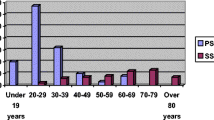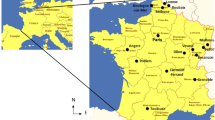Abstract
Spontaneous pneumothorax (SP) is defined as the presence of free air inside the pleural space. Many studies have reported that meteorological variables may trigger SP, but the mechanism is unknown. The aim of this study was to compare the effects of meteorological variables on the development of SP in two regions with different altitudes. The study was conducted in the Çanakkale (2 m above sea level) and the Erzurum region (1758 m). A total of 494 patients with SP who presented to the hospitals of the two regions between January 2011 and December 2016 were included in the study. The meteorological variables used included ambient temperature, atmospheric pressure, relative humidity, precipitation amount, wind speed, and wind direction (as north and south). The total 2192 days were divided into two as days with and without an SP case presentation. A 4-day period prior to the day a case presented was compared with the other days without any cases to investigate the presence of any lagged effect. Statistical significance was accepted at p < 0.05. Comparison of these two regions showed a significant difference between them. The meteorological variables of the regions that affect SP development were found to be low mean minimum temperature, high daily temperature change, low precipitation, low wind speed and north winds for Erzurum, and only rainy days for Çanakkale. The results have demonstrated that cold weather, sudden temperature changes, north winds, and low wind speed are risk factors for the development of SP at high altitudes.


Similar content being viewed by others
References
Abul Y, Karakurt S, Bostanci K, Yuksel M, Eryuksel E, Evman S, Celikel T (2011) Spontaneous pneumothorax and ozone levels: is there a relation? Multidisciplinary Resp Med 6:16–19
Akyıl M, Tezel Ç, Evman S, Akyıl FT, Vayvada M, Bayram S et al (2018) Correlation between meteorological changes and primary spontaneous pneumothorax: myth or fact? Turk Gogus Kalp Dama 26:436–440
Alifano M, Parri SNF, Bonfanti B, Arab WA, Passini A, Boaron M et al (2007) Atmospheric pressure influences the risk of pneumothorax: beware of the storm! Chest. 131:1877–1882
Aljehani Y, Niaz R, Almajid F, Elbawab H (2018) Influence of meteorological factors on the onset of primary spontaneous pneumothorax. Ann R Coll Surg Engl 100:606–611
Ayed AK, Bazerbashi S, Ben-Nakhi M, Chandrasekran C, Sukumar M, Al-Rowayeh A et al (2006) Risk factors of spontaneous pneumothorax in Kuwait. Med Princ Pract 15:338–342
Bense L (1984) Spontaneous pneumothorax related to falls in atmospheric pressure. Eur J Respir Dis 65:544–546
Bo QU, Jiang W, Liu Y, Zhou Z (2017) Influence of climatic factors on the incidence of spontaneous pneumothorax. J China Med Univ 46:169–172
Bulajich B, Subotich D, Mandarich D, Kljajich RV, Gajich M (2005) Influence of atmospheric pressure, outdoor temperature, and weather phases on the onset of spontaneous pneumothorax. Ann Epidemiol 15:185–190
Çelik B, Çelik HK, Hamzacebi H, Demir H, Furtun K, Ortamevzi C (2009) The role of meteorological conditions on the development of spontaneous pneumothorax. Thorac Cardiovasc Surg 57:409–412
Chen CH, Kou YR, Chen CS, Lin HC (2010) Seasonal variation in the incidence of spontaneous pneumothorax and its association with climate: a nationwide population-based study. Respirology. 15:296–302
Comelli I, Bologna A, Ticinesi A, Magnacavallo A, Comelli D, Meschi T et al (2017) Incidence of primary spontaneous pneumothorax is not associated with microclimatic variations. Results of a seven-year survey in a temperate climate area. Monaldi Arch Chest Dis 87:22–26
Díaz R, Díez MM, Medrano MJ, Vera C, Guillamot P, Sánchez A, Ratia T, Granell J (2014) Influence of atmospheric pressure on the incidence of spontaneous pneumothorax. Cir Esp 92:415–420
Haga T, Kurihara M, Kataoka H, Ebana H (2012) Influence of weather conditions on the onset of primary spontaneous pneumothorax: positive association with decreased atmospheric pressure. Ann Thorac Cardiovasc Surg 19:212–215
Heyndrickx M, Le Rochais JP, Icard P, Cantat O, Zalcman G (2015) Do atmospheric conditions influence the first episode of primary spontaneous pneumothorax? Interact Cardiovasc Thorac Surg 21:296–300
Körner C (2007) The use of ‘altitude’ in ecological research. Trends Ecol Evol 22:569–574
Mishina T, Watanabe A, Miyajima M, Nakazawa J (2017) Relationship between onset of spontaneous pneumothorax and weather conditions. Eur J Cardiothorac Surg 52:529–533
Obuchi T, Miyoshi T, Miyahara S, Hamanaka W, Nakashima H, Yanagisawa J, Hamatake D, Imakiire T, Yoshinaga Y, Shiraishi T, Iwasaki A (2011) Does pneumothorax occurrence correlate with a change in the weather? Surg Today 41:1380–1384
Oruç M, Şahin A, Dursun R, Taylan M, Erbey A, Meteroglu F et al (2016) Do meteorological changes have an effect on the occurence of spontaneous pneumothorax? Turk Thorac J 17:89–92
Özpolat B, Gözübüyük A, Koçer B, Yazkan R, Dural K, Genç O (2009) Meteorological conditions related to the onset of spontaneous pneumothorax. Tohoku J Exp Med 217:329–334
Schieman C, Graham A, Gelfand G, McFadden SP, Tiruta C, Hill MD et al (2009) Weather and Chinook winds in relation to spontaneous pneumothoraces. Can J Surg 52:E151–E155
Smit HJ, Devillé WL, Schramel FM, Schreurs AJ, Sutedja TG, Postmus PE (1999) Atmospheric pressure changes and outdoor temperature changes in relation to spontaneous pneumothorax. Chest 116:676–681
Suarez-Varela MM, Martinez-Selva MI, Llopis-Gonzalez A, Martinez-Jimeno JL, Plaza-Valia P (2000) Spontaneous pneumothorax related with climatic characteristics in the Valencia area (Spain). Eur J Epidemiol 16:193–198
Yamac ME, Karapolat S, Turkyilmaz A, Seyis KN, Tekinbas C (2017) Relationship of spontaneous pneumothorax cases seen in Eastern Black Sea region with meteorological changes. Int J Biometeorol 61:1493–1498
Zhang GJ, Gao R, Fu JK, Jin X, Zhang Y, Wang Z (2012) Climatic conditions and the onset of primary spontaneous pneumothorax: an investigation of the influence of solar terms. Med Princ Pract 21:345–349
Funding
This study has been supported by the Çanakkale Onsekiz Mart University Scientific Research Project TSA-2018-2634.
Author information
Authors and Affiliations
Corresponding author
Ethics declarations
This study was approved by the Clinical Studies Ethics Committee of the Çanakkale Onsekiz Mart University Faculty of Medicine with project no. 66237542-202.03.02-47393 and was supported as Scientific Research Project TSA-2018-2634.
Conflict of interest
The authors declare that they have no conflict of interest.
Additional information
Publisher’s note
Springer Nature remains neutral with regard to jurisdictional claims in published maps and institutional affiliations.
Rights and permissions
About this article
Cite this article
Daş, M., Alar, T., Delice, O. et al. The effect of meteorological variables on spontaneous pneumothorax in two regions with different altitudes. Int J Biometeorol 65, 503–511 (2021). https://doi.org/10.1007/s00484-020-02040-6
Received:
Revised:
Accepted:
Published:
Issue Date:
DOI: https://doi.org/10.1007/s00484-020-02040-6




